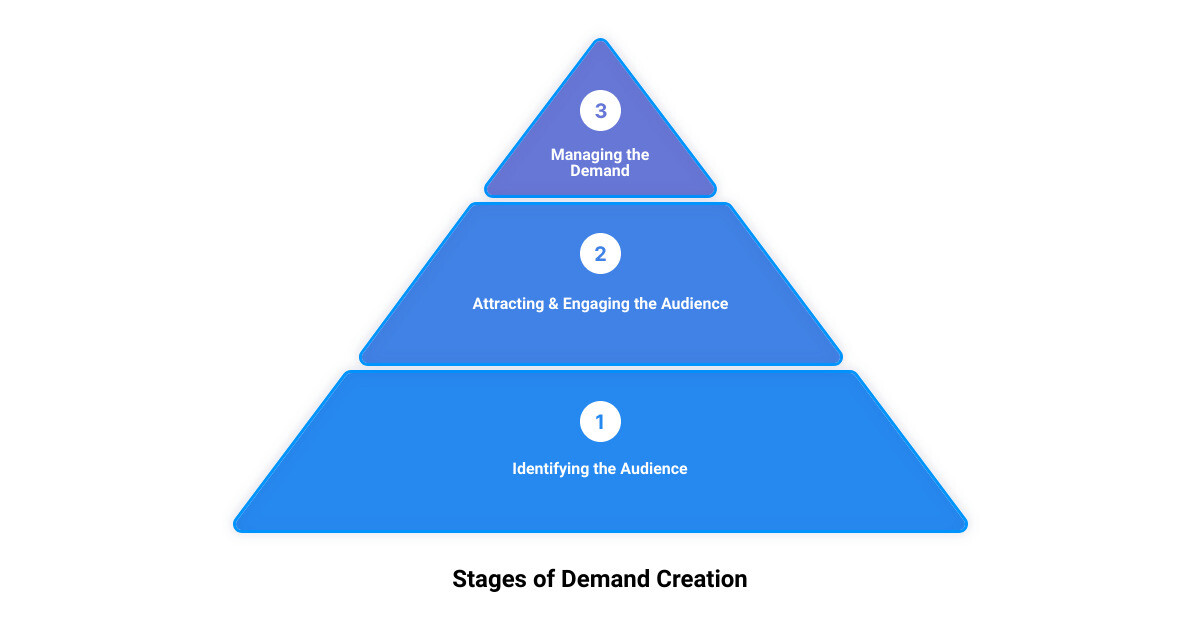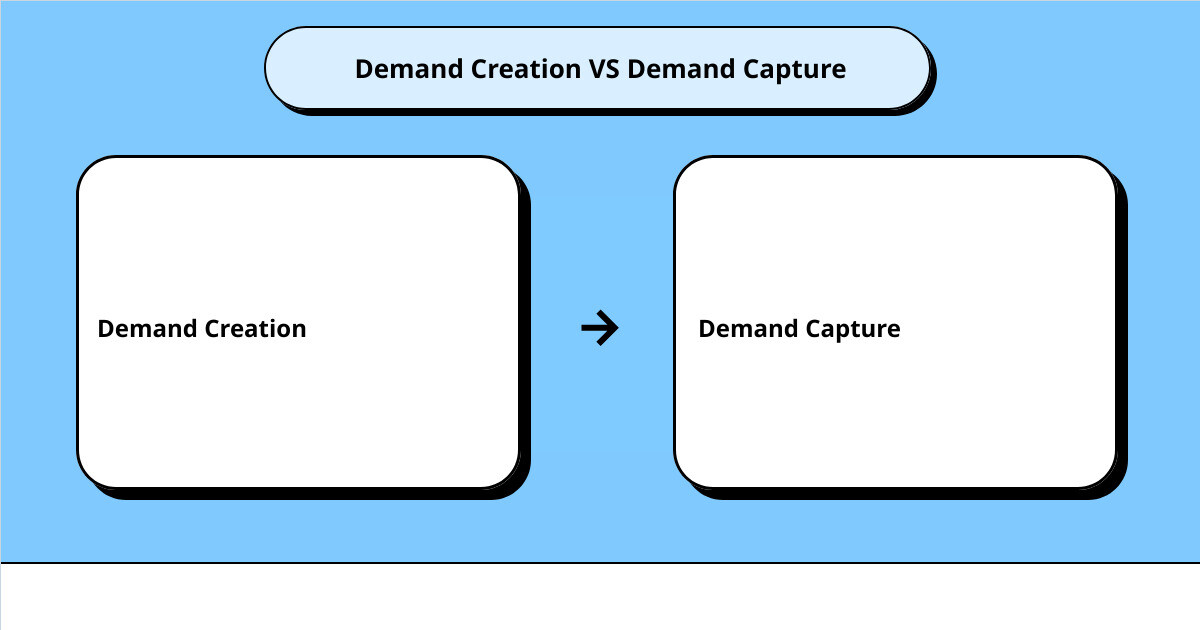There’s a famous quote by American inventor, Thomas Edison: “Genius is one percent inspiration, ninety-nine percent perspiration.” In the world of B2B marketing, we could say that growth is one percent invention and ninety-nine percent demand creation. For HR technology companies facing the hurdle of a saturated market, demand creation is the catalyst that ignites the flame of interest, fueling the pipeline for greater revenue growth. It’s no longer enough to have an innovative product or service; you need to master the art of sparking desire in your potential customers.
In this article, ‘The Art of Igniting Desire: Mastering the Demand Creation Process,’ we will delve into the intricacies of demand creation, differentiating it from demand generation, exploring its stages, the role of data, and its impact on revenue growth. We will also illustrate how GrowthMode Marketing employs demand creation to aid HR tech companies in reaching their target audience and driving high growth.
Stay tuned as we unravel the secret to successful demand creation, helping you establish an influential digital footprint, build brand awareness, credibility, and trust among your ideal customer profile audience. By the end of this article, you’ll have a profound understanding of how to utilize demand creation to set your brand ablaze in the marketplace.
The Difference Between Demand Creation and Demand Generation
As we delve deeper into the realm of demand strategy, it’s crucial to understand the distinction between demand creation and demand generation. While the terms may seem synonymous, they refer to distinct processes in the marketing landscape, each with its unique role and impact on a brand’s growth.
Demand Creation: A Holistic Approach to Generating Demand
Demand creation embodies a holistic approach to marketing. It’s all about creating a need or desire for your product or service within your target market. The objective isn’t just to sell but to build an enduring relationship with your audience, igniting excitement and anticipation for your brand.
The process encompasses strategic marketing tactics such as content marketing, SEO, social media advertising, and video marketing. The goal is to educate, inform, and captivate your audience, fostering an understanding of your brand’s value proposition and cultivating a sense of need for your offerings.
Metrics associated with demand creation focus on engagement and awareness rather than direct conversions or sales. Variables such as content interactions, clicks, views, comments, shares, brand keyword rankings, and the rate at which customers are attracted to the business (sales velocity) are key indicators of the effectiveness of your demand creation strategies.
Demand Generation: Building Brand Awareness and Interest
While demand creation focuses on fostering a need for your brand, demand generation is the process of building and nurturing an interest in your products or services. It’s about positioning your brand in front of your audience, piquing their interest, and guiding them towards becoming potential buyers.
Demand generation strategies include both traditional media strategies like TV commercials and radio ads and digital solutions like paid display ads, email campaigns, and content production. The aim is to raise brand awareness and stimulate interest, attracting new prospects and sales opportunities to your business.
However, unlike demand creation, demand generation is more directly tied to sales and conversions. It focuses on pushing potential buyers through the sales funnel with the ultimate goal of generating revenue.
In essence, while both demand creation and demand generation are crucial for business growth, they serve different purposes in the marketing ecosystem. Understanding these differences is pivotal to devising a comprehensive and effective demand strategy.
The Four Stages of the Demand Creation Process
Every masterpiece starts with a blank canvas and the right set of brushes. Similarly, the art of igniting desire through demand creation begins with a raw audience and the right approach. The process of demand creation can be broken down into four key stages: identifying the right audience, attracting the audience, engaging the audience, and managing the demand.
Identifying the Right Audience: The First Step in Demand Creation
The first brushstroke in the demand creation process involves identifying the right audience. Without a clear understanding of who your potential customers are, your marketing efforts may be akin to throwing paint at the wall and hoping it sticks. To avoid wasting resources, it’s crucial to conduct thorough research to understand your market. This could involve persona research, voice of customer research, and competitive research, among other methodologies. The end goal is to have a clear picture of your ideal customer profile.
Attracting the Audience: Using Marketing Tactics to Ignite Interest
Once you have identified your target audience, the next step is to attract them to your brand. This is where your marketing tactics, such as content marketing, SEO, and digital advertising, come into play. The aim is to generate brand awareness and interest, positioning your company in front of your ideal audience. For instance, you might leverage content that aligns with the buyer journey, which is a key component of effective demand generation.
Engaging the Audience: The Role of Calls to Action in Demand Creation
After attracting your audience, the next stage is to engage them. One way to do this is by providing clear and enticing calls to action in your marketing communications. This could be as simple as clicking a button or calling a number, but the key is to make it easy for your audience to raise their hand and show interest in your product or service. This is also an opportunity to collect valuable information from your leads, fostering stronger relationships and enabling more personalized marketing efforts.
Managing the Demand: Closing Sales and Growing Customer Relationships
The final stage in the demand creation process is managing the demand you’ve generated. This involves nurturing leads, enabling sales, and ultimately, closing those leads into sales. It’s not enough to just generate demand; you need to follow through and convert that demand into revenue. This requires a robust lead management process and a strong alignment between your marketing and sales teams.
In conclusion, the demand creation process is a multi-step journey that requires a targeted and strategic approach. From identifying your audience to managing the demand, each stage plays a critical role in driving growth and revenue. By mastering this process, your company can effectively ignite desire and convert potential leads into loyal customers.
The Role of Data in the Demand Creation Process
Information is power, and in the realm of demand creation, data is the key that unlocks the door to success. Data-driven insights not only guide your approach in the initial stages but also help you fine-tune your strategies as you progress. The demand creation process relies heavily on the quality and quantity of data gathered and how it is analyzed to shape up your marketing strategies.
Measuring the Quality and Quantity of Data
In the galaxy of demand creation, data is the North Star, guiding your marketing ship to the right audience. However, it’s not just about collecting a vast amount of data. The quality of data gathered is equally, if not more, important.
Quality data is accurate, complete, and relevant to your target market. It helps you identify your ideal customer profile, understand their needs, and tailor your marketing efforts to address those needs effectively.
On the other hand, the quantity of data ensures you have a large enough sample to make accurate predictions and draw reliable conclusions. It enables you to understand the broader market trends, customer behavior patterns, and the effectiveness of your marketing strategies.
Measuring the quality and quantity of data involves keeping track of key metrics such as the number of meetings or opportunities generated, average deal size, sales pipeline value, customer acquisition cost, cost per lead, customer lifetime value, and average sales cycle length[^1^]. These metrics provide valuable insights into the effectiveness of your demand creation strategies and help you optimize them for better results.
Understanding the Impact of Demand Creation on Revenue Growth
The ultimate goal of any business strategy, including demand creation, is to drive revenue growth. Therefore, understanding the impact of your demand creation efforts on revenue growth is critical.
The link between demand creation and revenue growth is not always direct or immediate. However, over time, a successful demand creation strategy will manifest in lower customer acquisition costs, decreased sales cycle time, increased deal size, and pipeline value[^2^].
Mapping these metrics to your demand creation efforts can provide valuable insights into what’s working and what’s not. This information can help you refine your strategies, allocate resources more effectively, and ultimately drive more significant revenue growth.
In conclusion, data plays a pivotal role in the demand creation process. It helps you understand your target audience, measure the effectiveness of your marketing strategies, and monitor the impact of your efforts on revenue growth. By leveraging data effectively, you can master the art of igniting desire and transform potential leads into loyal customers, ultimately driving growth and success for your business.
[^1^]: 3 Common Demand Gen Mistakes and How to Avoid Them – GrowthMode Marketing
[^2^]: The 3 Ds of Successful Demand Creation – DemandGen
Demand Creation in Action: A Case Study of GrowthMode Marketing
Let’s dive headfirst into the world of demand creation by examining how GrowthMode Marketing, a leading B2B marketing agency, uses this powerful strategy to drive growth for HR tech companies.
How GrowthMode Marketing Uses Demand Creation to Help HR Tech Companies
GrowthMode Marketing, with its unique blend of growth marketing principles and traditional marketing strategies, has carved out a niche for itself as a reliable ally for HR tech companies looking to build, grow and drive demand. Their approach to demand creation is heavily centered around understanding the unique business objectives of their clients and ensuring their investment aligns with the broader strategic vision[^1^].
One of the ways GrowthMode Marketing excels in demand creation is by leveraging their deep industry expertise. Their team has extensive experience in the HR technology and employer services industry, which provides them with the knowledge needed to create demand in this specific space[^1^].
Once the target audience is defined, GrowthMode Marketing sets about creating a custom demand generation strategy. This could involve using content marketing, campaigns, social media, digital advertising, and account-based marketing (ABM) to attract the audience[^1^].
But it’s not just about attracting the audience. GrowthMode Marketing also emphasizes the importance of engaging the audience. They believe in giving the audience an easy way to respond to ads, emails, and other communications. This could be as simple as including a clear call to action where the audience can click a button or call a number[^1^].
The Results: How Demand Creation Has Driven Success for GrowthMode Marketing’s Clients
By adopting this holistic approach to demand creation, GrowthMode Marketing has consistently been able to drive success for their clients. However, success isn’t just about creating demand. It’s about managing that demand effectively to close sales, grow customer relationships, and realize revenue[^1^].
One of the ways GrowthMode Marketing ensures this is by handling all nurturing, sales enablement, and lead recycling/reconstitution activities. This proactive approach to lead management, combined with their strong demand creation discipline, has proven to be effective in accelerating revenue growth[^1^].
In conclusion, GrowthMode Marketing’s approach to demand creation demonstrates that it’s not just about building brand awareness and attracting an audience. It’s about engaging the audience and managing demand effectively to drive growth and success. It’s a testament to the power of a well-executed demand creation strategy in the B2B marketing landscape.
The Balance Between Demand Creation and Demand Capture
In the marketing world, it’s often said that balance is key. This is especially true when it comes to the dual strategies of demand creation and demand capture. Both strategies have their own unique roles and advantages, but when used in concert, they can create a powerful synergy that drives a brand’s success.
The Importance of Demand Creation in the Early Stages of the Buyer Funnel
In the initial stages of the buyer’s journey, demand creation plays a pivotal role. It’s all about sparking interest, generating awareness, and building a brand’s visibility. This stage involves reaching out to the market as a whole, attracting prospects, and making them aware of the brand’s offerings.
But it’s not just about getting the brand’s name out there. It’s also about educating the market. This is where compelling, value-rich content comes into play. Content that resonates with the target audience, that speaks to their needs, and that establishes the brand as a trustworthy, knowledgeable authority in its field.
In this phase, metrics such as reach, engagement, and SERP visibility are crucial indicators of success. They show how effectively the brand is making itself known and how well it is resonating with its audience.
The Role of Demand Capture in Personalizing the Marketing and Sales Strategy
Once a brand has successfully created demand and drawn prospects into its sales funnel, the focus shifts to demand capture. This strategy is all about engaging the high-intent buyers who are already aware of the brand and its offering.
The aim here is to prevent the interest generated by demand creation from going to waste. Brands use targeted, paid marketing, landing pages, and lead magnets to capture the attention of these potential customers. They leverage intent-based data to create personalized campaigns that guide these prospects further down the sales pipeline.
Demand capture also involves measures like account-based marketing (ABM), which sends customized communications based on a customer’s previous interactions with the brand. It can also involve using online ads targeted at people ready to make a purchase, or setting up automated workflows that leverage customer data for personalized sales.
In this phase, the key performance indicators tend to be more sales-oriented. Brands look at average conversion rates, ROI, win rate, Customer Lifetime Value (CLV), and marketing cycle length to assess the success of their demand capture efforts.
In conclusion, both demand creation and demand capture are crucial components of a holistic marketing strategy. They’re two sides of the same coin, and it’s the balance between the two that can help a brand maximize its reach, engagement, and ultimately, its sales.
Mastering the art of demand creation requires a thorough understanding of your audience, careful planning, and consistent execution across all marketing channels. It’s not just about generating leads, but creating a genuine demand for your product or service that resonates with the needs and wants of your target customer base.
As an HR technology company or workforce technology company, you face a cluttered market, and the need to stand out is greater than ever. Through a well-thought-out demand creation strategy, you can build your digital footprint, attract your ideal customer profile audience, and create a strong brand presence.
GrowthMode Marketing has successfully used demand creation to help HR tech companies grow their revenue. By leveraging data analytics, content marketing, and other digital marketing strategies, they’ve been able to generate a buzz around their clients’ products and services, attract and engage their target audience, and ultimately drive high growth.
On the other hand, demand capture focuses on personalizing the marketing and sales strategy to effectively convert leads into customers. It’s about capturing the interest of prospects who are already in the buying funnel and guiding them towards making a purchase.
In the end, the key to mastering the art of demand creation lies in striking a balance between demand creation and demand capture. By understanding the importance of both and how they can complement each other, you can create a comprehensive marketing strategy that drives growth and success. Remember, demand creation is not a one-time effort but a long-term strategy that needs continuous tweaking and improvement for optimal results.
It’s time to ignite desire for your brand, create demand for your products or services, and watch your business grow. With the right strategy, the right team, and the right tools, demand creation becomes less of a challenge and more of an opportunity for growth and success.
So, are you ready to master the art of demand creation? With GrowthMode Marketing, you’ll be equipped with the right strategies, tools, and expertise to make it happen.






